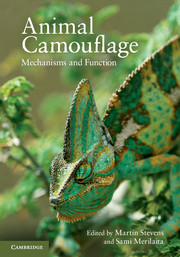Book contents
- Frontmatter
- Contents
- Contributors
- 1 Animal camouflage
- 2 Crypsis through background matching
- 3 The concealment of body parts through coincident disruptive coloration
- 4 The history, theory and evidence for a cryptic function of countershading
- 5 Camouflage-breaking mathematical operators and countershading
- 6 Nature's artistry
- 7 Camouflage behaviour and body orientation on backgrounds containing directional patterns
- 8 Camouflage and visual perception
- 9 Rapid adaptive camouflage in cephalopods
- 10 What can camouflage tell us about non-human visual perception? A case study of multiple cue use in cuttlefish (Sepia spp.)
- 11 Camouflage in marine fish
- 12 Camouflage in decorator crabs
- 13 Camouflage in colour-changing animals
- 14 The multiple disguises of spiders
- 15 Effects of animal camouflage on the evolution of live backgrounds
- 16 The functions of black-and-white coloration in mammals
- 17 Evidence for camouflage involving senses other than vision
- Index
- Plate section
- References
14 - The multiple disguises of spiders
Published online by Cambridge University Press: 05 June 2012
- Frontmatter
- Contents
- Contributors
- 1 Animal camouflage
- 2 Crypsis through background matching
- 3 The concealment of body parts through coincident disruptive coloration
- 4 The history, theory and evidence for a cryptic function of countershading
- 5 Camouflage-breaking mathematical operators and countershading
- 6 Nature's artistry
- 7 Camouflage behaviour and body orientation on backgrounds containing directional patterns
- 8 Camouflage and visual perception
- 9 Rapid adaptive camouflage in cephalopods
- 10 What can camouflage tell us about non-human visual perception? A case study of multiple cue use in cuttlefish (Sepia spp.)
- 11 Camouflage in marine fish
- 12 Camouflage in decorator crabs
- 13 Camouflage in colour-changing animals
- 14 The multiple disguises of spiders
- 15 Effects of animal camouflage on the evolution of live backgrounds
- 16 The functions of black-and-white coloration in mammals
- 17 Evidence for camouflage involving senses other than vision
- Index
- Plate section
- References
Summary
This chapter aims at a broad exploration of the literature pertinent to the subject of spider camouflage, from web colour and decorations, body colour to movement. It is an extended and updated version of a previous paper (Théry & Casas 2009). Several functions have been assigned to spider web decorations, the most extensively studied being visually related, like camouflage from predator and/or prey, prey attraction and signalling to animals that are likely to damage the web (Herberstein et al. 2000; Bruce 2006). The function of these structures is highly controversial, as also are other visual aspects of spider ecology, like the appearance of spiders themselves. Moreover, a few spider species have the ability to change their body coloration, a peculiarity that has been suggested to improve camouflage or to constitute a form of aggressive mimicry (Oxford & Gillespie 1998). Are such visual appearances used to lure prey, deter predators or hide from predators or prey?
- Type
- Chapter
- Information
- Animal CamouflageMechanisms and Function, pp. 254 - 274Publisher: Cambridge University PressPrint publication year: 2011
References
- 2
- Cited by



